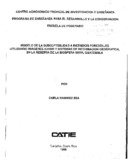| dc.contributor.advisor | Jones, Jeffrey | es_ES |
| dc.contributor.author | Ramírez Zea, Carla | |
| dc.date.accessioned | 2020-11-13T02:37:45Z | |
| dc.date.available | 2020-11-13T02:37:45Z | |
| dc.date.issued | 1999 | |
| dc.identifier.uri | https://repositorio.catie.ac.cr/handle/11554/9924 | |
| dc.description | Tesis (Mag. Sc.)--CATIE, Turrialba (Costa Rica) 1999 | es_ES |
| dc.description | Ilustraciones, tablas | |
| dc.description | Referencias de las páginas 76-80 | |
| dc.description.abstract | Para contribuir con los planes de prevención y control de incendios forestales del área, en el presente trabajo se realizó un análisis geográfico para determinar cuales son las áreas más amenazadas dentro de la reserva. El resultado fue un mapa que muestra tres clases de susceptibilidad, las cuales indican mayor efecto en aquellas zonas donde se encuentran presentes las tres variables antropogénicas. La variable con mayor valoración fue la frontera agrícola, seguido de los poblados y vías de acceso. La vegetación juega un papel menos drástico aunque no deja de ser importante ya que puede determinar una rápida propagación según sus condiciones por la sequía. Las áreas más susceptibles son las que se encuentran en las áreas habitadas dentro de la reserva, el borde con la zona de amortiguamiento y las zonas fronterizas con México al Oeste. | es_ES |
| dc.description.abstract | In order to contribute to the prevention and control plans for forest fires in the area, in this paper a geographical analysis was carried out to determine which are the most threatened areas within the reserve. The result was a map that shows three classes of susceptibility, which indicate a greater effect in those areas where the three anthropogenic variables are present. The variable with the highest value was the agricultural frontier, followed by towns and access roads. Vegetation plays a less drastic role, although it is still important since it can determine a rapid spread depending on its conditions due to drought. The most susceptible areas are those found in the inhabited areas within the reserve, the border with the buffer zone and the border areas with Mexico to the West. | |
| dc.format.extent | 79 páginas | |
| dc.language.iso | es | es_ES |
| dc.publisher | Centro Agronómico Tropical de Investigación y Enseñanza, Turrialba (Costa Rica) (CATIE) | es_ES |
| dc.subject | GUATEMALA | |
| dc.subject | INCENDIOS FORESTALES | |
| dc.subject | INSTRUMENTOS METEOROLOGICOS | |
| dc.subject | MODELOS | |
| dc.subject | RESERVA DE LA BIOSFERA MAYA | |
| dc.subject | SISTEMAS DE INFORMACION GEOGRAFICA | |
| dc.subject | TELEDETECCION | |
| dc.subject | ZONIFICACION | |
| dc.subject | FOREST FIRES | |
| dc.subject | GEOGRAPHICAL INFORMATION SYSTEMS | |
| dc.subject | METEOROLOGICAL INSTRUMENTS | |
| dc.subject | MODELS | |
| dc.subject | REMOTE SENSING | |
| dc.subject | ZONING | |
| dc.title | Modelo de la susceptibilidad a incendios forestales utilizando imágenes AVHRR y sistemas de información geográfica, en la Reserva de la Biosfera Maya, Guatemala | es_ES |
| dc.type | Tesis | es_ES |


